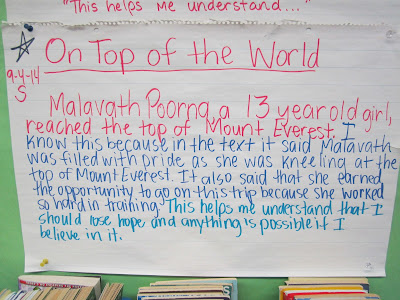Writing About Reading
A reading notebook is a journey of thought.
Wednesday, July 15, 2015
Adding Evidence
We will continue to work on writing about reading this year. Thought + Evidence + Higher Level Thinking. I am excited to show students a variety of ways to use evidence. I think this will help make entries more sophisticated! Looking forward to a great school year in 2015-2016!
Theme
Theme: The lesson learned. It is the big idea or message of the text. It can go across several books.
It is a post reading strategy so you determine theme after reading a book. It is a good practice to have students write about theme every time they finish a book. Theme is a high leverage standard and one that students must know. It is important to model theme with both familiar picture books and chapter books.
It is a post reading strategy so you determine theme after reading a book. It is a good practice to have students write about theme every time they finish a book. Theme is a high leverage standard and one that students must know. It is important to model theme with both familiar picture books and chapter books.
Symbolism
Backstory
4th and 5th grade students begin to learn the importance of backstory. Backstory can help you form character theories, anticipate possible problems, help students infer and understand why a character might behave the way they do or what motivates them..the list goes on and on. Backstory of the main character is often introduced in the beginning of a book (not always) and continues throughout the book in clues, snippets, or perhaps flashbacks. You also learn the backstory of other characters throughout the book at times.
Entries in Nonfiction
5th grade nonfiction entry at the beginning of the year. Just keeping with the entry formula of thought + evidence + higher level thinking.
There are many ways to write about text structure. We believe that if students can identify the text structure and evidence to support that then it will not only deepen their understanding but also help them when writing nonfiction. 4th and 5th grade used scholastic news a lot. The articles are not to long and are current. The students seem to like them too!
There are many ways to write about text structure. We believe that if students can identify the text structure and evidence to support that then it will not only deepen their understanding but also help them when writing nonfiction. 4th and 5th grade used scholastic news a lot. The articles are not to long and are current. The students seem to like them too!
Problem/ Resolution
There is always a discussion between problem/solution and problem/resolution. Sometimes students struggle with this fairly simple concept. Whenever this happens, teachers really try and define the concepts and give several examples.
Problem - What is wrong in the book or what needs to be fixed
Solution- How the problem is fixed or solved
However, the problem is not always fixed or solved. Sometimes it is resolved. So we tell students that resolution is when something is settled or a decision has been made. As students get older, many problems their characters face are not solved but resolved. This takes practice and there are many ways to write about this. This is one way that the concept was introduced.
Problem - What is wrong in the book or what needs to be fixed
Solution- How the problem is fixed or solved
However, the problem is not always fixed or solved. Sometimes it is resolved. So we tell students that resolution is when something is settled or a decision has been made. As students get older, many problems their characters face are not solved but resolved. This takes practice and there are many ways to write about this. This is one way that the concept was introduced.
Wednesday, June 3, 2015
Social Issues
We want students to recognize social issues in books. We also want students to recognize social issues around them and in the world. (4th and 5th grade)
Higher level thinking on social issue entries can also include a call to action.
These entries still have a thought + evidence + Higher Level Thinking.
Subscribe to:
Comments (Atom)






















